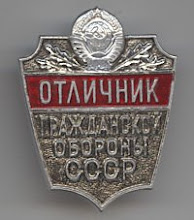Although it is likely to surprise readers who associate cogeneration with Lovins' criticisms of "centralized planning," the Soviets were actually huge fans of cogeneration. This might be taken as evidence that cogeneration isn't necessarily all it's cracked up to be, as anyone who has lived in St. Petersburg in the summer when the municipal hot water is turned off can tell you. I imagine it's a lot less fun when the system fails during the winter, which I've heard about but have been mercifully spared in my own experience. Because of these problems it's increasingly common for Russians to install water heaters in their apartments.
Whatever the shortcomings of the centralized water and space heating systems found in Soviet cities, they combined with the Soviet penchant for nuclear technology to inspire the creation of the Атомная теплоэлектроцентраль (АТЭЦ)--a nuclear plant designed to produce both heat and electricity. Officially, this term was reserved for a special variant of the VVER-1000 that was under construction in Odessa and Kharkov in the 1980s. These plants were canceled following Chernobyl. However, the principle of nuclear cogeneration was demonstrated before this at the Bilibinskaia AES in northeastern Siberia.
The Bilibinskaia plant is one of the more unusual in Rosenergoatom's fleet. Whereas most Russian nuclear plants are either VVER LWRs or RBMKs, Bilibino's consists of four comparatively tiny EGP-6 graphite-moderated boiling-water reactors with a total electrical output of only 48 MW total. The plant began construction in the mid-1960s and the first reactor went into service in 1974. It provides both heat and power to the city of Bilibino, which is a small gold-mining town of only 5700 people. In part as a result of this low demand, the plant operates at a low capacity factor--well under 40% in recent years.
So here's what I'm wondering: why isn't the Bilibino nuclear plant "micropower?" It's much smaller than some of the fossil-fuel fired cogeneration plants that RMI includes in its statistics for "micropower," and it certainly has a better claim for climate-friendliness. In Forget Nuclear, RMI defined "micropower" as follows:
1. onsite generation of electricity (at the customer, not at a remote utility plant)—usually cogeneration of electricity plus recovered waste heat (outside the U.S. this is usually called CHP—combined-heat-and-power): this is about half gas-fired, and saves at least half the carbon and much of the cost of the separate power plants and boilers it displaces;It's pretty clear that most of the combined heat and power (CHP) plants in RMI's statistics are larger than Bilibino and no less removed from the consumer. But somehow I doubt that Bilibino has ever been included in RMI's tally of "micropower," or that Soviet plutonium-production reactors that also served a similar role in their cities of residence were included. I wonder why?
2. distributed renewables—all renewable power sources except big hydro plants, which are defined here as dams larger than 10 megawatts (MW).


3 comments:
Nuclear district heating is a great idea and one that has been given little attention in the West. It is particularly suitable for Northern communities that must import oil from great distances, and that already have networks installed.
In the 1970's AECL designed a version of their SLOWPOKE reactors that would have been ideal for small district heating applications. Due to its unique design the SLOWPOKE type reactors are inherently safe and as such does not require a complex SCRAM system or twenty-four hour staffing, in fact it is the only design in the world licensed for unattended operation. The economics of a district-heating system based on SLOWPOKE-3 technology were estimated to be competitive with that of conventional fossil fuels even at the time.
Indifference and poor marketing killed the SLOWPOKE. Eventually the the Chinese reverse engineered it and have sold several of their knock-offs, called the Miniature Neutron Source Reactor, around the world.
The Soviets were on the right track and if the had any problems with reliability, it was probably due more to the condition of the equipment and the network, than in any inherent issues with the concept itself.
I think the cancellation of these projects was the result of late-1980s doubts about nuclear power and the economic implosion of the USSR. It sounds like Odessa was much further along, but its location in Ukraine had forestalled any discussion of reviving the project until recently. I think that the 1000 MWe scale the Soviets were working on was too large. Smaller PBMR or MSR designs would be better-suited to this task, in my view.
I am a bit late to this discussion, but the US Army operated several reactors in remote areas that were specifically designed to provide both district heating and electricity.
These reactors were constructed and operated under the ice in PM-2A at Camp Century Greenland, the PM-1 at Sundance Wyoming, the PM-3A at McMurdo Station in Antarctica and and SM-1A at Fort Greenly in Alaska. In addition, the Army also operated a 10 MWe floating power plant on the Sturgis, a converted Liberty ship that was docked in the Panama Canal Zone for more than 10 years.
There is no technical reason at all that fission heat cannot be applied in small, cogeneration units just as readily as combustion heat. In fact, since fission reactors do not produce any noxious, smoky discharges, they are more appropriate for close location with other industry.
Post a Comment